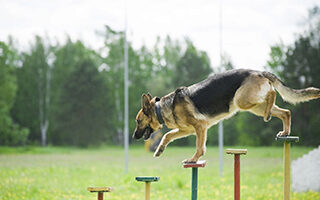
August 26 is National Dog Day, a time to celebrate all the awesomeness that is our canine companions. In salute to them, this week’s Veteran Energy blog covers a short history of dogs in the U.S. military. Enjoy.
For thousands of years, dogs have been used in war as trackers and lookouts and even in battle. Some cultures even fitted their canines of combat with spiked collars and suits of armor.
But in the U.S., the first recorded use of dogs in war was during the Second Seminole War (1835-1842). Playing off the success of the British in crushing a Jamaican uprising 100 years earlier, the U.S. Army purchased Cuban-bred bloodhounds. The dogs helped ferret out Seminole Indians hiding out in the wildest parts of Florida.
Almost 20 years later, dogs would have also been seen with soldiers on both sides of the Civil War. But not in any kind of official capacity. That wouldn’t come again until the beginning of the Spanish-American War, just before the turn of the century. In that conflict, Col. Teddy Roosevelt and his Rough Riders used dogs to help prevent enemy ambushes in the jungles of Cuba.
By World War I (1914), America still didn’t have a formal military dog training program. But the U.S. saw how well other countries used dogs in war. And so we secured some trained pooches from France and Britain. Eventually, America’s World War I soldiers used dogs as sentries, scouts, messengers, ratters and for finding casualties and explosives.
Although lots of dog breeds were used, Doberman pinschers and German shepherds proved to be two of the most popular. Both breeds were (and are) smart and easy to train. And they worked well as guard dogs.
Soon after America entered World War II, U.S. Secretary of War Harold Stimson called for an official military dog training program. By the end of 1942, there were dog handlers in each branch of the military with dogs under their command. The first canines from the U.S. War Dog Program worked as messengers, sentries, mine detectors and, in icy climates, sled dogs.
Dogs were important in the Korean War (1950), too, but it was the Vietnam War a few years later that would really boost the numbers of combat canines. An estimated 5,000 dogs were trained and shipped to the jungles of Vietnam in the 1960s and 1970s.
With superior hearing, smell and vision, dogs helped extend the senses of combat soldiers in the jungle. They also helped detect mines, trip wires and enemy bunkers and tunnels underground. German shepherds and Dobermans continued to be the dogs of choice for many years, though the latter was eventually replaced by the Labrador retriever.
In more recent times, too, dogs have made a mark with our fighting forces in such places as Iraq and Afghanistan. A recent count estimates there to be about 1,600 Military War Dogs (MWDs) serving in the field or assisting wounded veterans with recovery. Many of those MWDs are trained right here in Texas at Lackland Air Force Base.
Veteran Energy is privileged to recognize all members of our brave fighting forces, and we don’t want to exclude our country’s four-legged warriors. Thank you for helping us honor these heroic hounds on National Dog Day.


